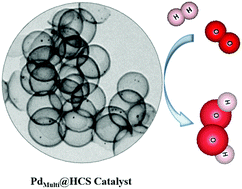Synthesis and performance of PdMulti@HCS catalysts with Pd nanoparticles partially embedded in the inner wall of hollow carbon spheres for the direct synthesis of hydrogen peroxide from hydrogen and oxygen†
Abstract
PdMulti@HCS catalysts with Pd nanoparticles partially embedded in the inner wall of hollow carbon spheres were synthesized by a hard template method. The synthesis process of PdMulti@HCS catalysts and the influence of the pore structure of the hollow carbon shell on the catalytic performance for the direct synthesis of H2O2 from H2 and O2 were systematically researched in this work. When the mass ratio of resorcinol (R) and formaldehyde (F) was R/F = 0.20 g/0.286 g, the mass of CTAB was 2.0 g, and the additional amount of 0.075 M H2PdCl4 solution was 1.0 ml; Pd nanoparticles obtained by in situ reduction using freshly prepared NaBH4 solution with an average size of 6.7 nm showed good dispersion and partial embedding in the inner wall of the hollow carbon shell. The average size of cavity diameter and the hollow carbon shell thickness were 145 nm and 8.03 nm, respectively. More importantly, there were a large number of micropores with a pore size distribution of 1.5 nm in the hollow carbon shell. This special hollow structure ensured the maximum exposure of Pd active sites and the optimal transfer and diffusion ability, which were conducive to improving the catalytic activity and stability of the PdMulti@HCS catalysts.



 Please wait while we load your content...
Please wait while we load your content...